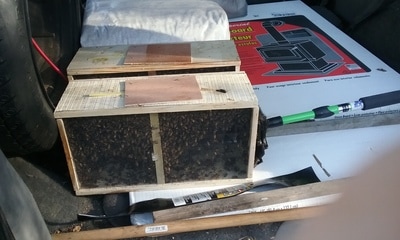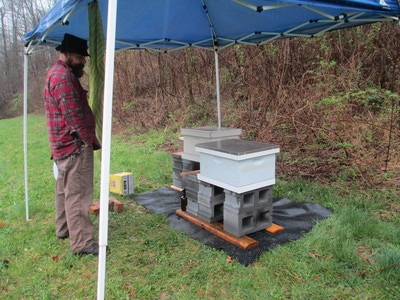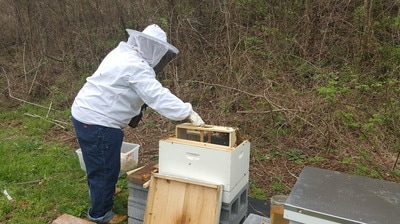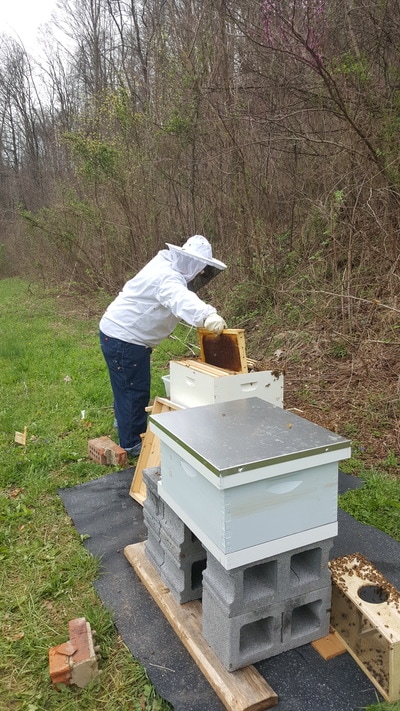A few weeks ago we brought home two packages of bees, each with approximately 10,000 bees. This was the first time we had to transport bees, purposely, inside a vehicle. I was nervous even though I knew the wooden boxes filled with bees were designed to keep them in and not let them out. It was a beautiful, sunny, warm Sunday when we picked them up. The drive home was uneventful, but it was almost 6:30 PM by the time we made it home. Too late to try and introduce bees to their new home. So, we placed each package in its hive box, put the lid on it, and called it a night. The plan was, the next morning we'd empty the packages into the hives and then follow the normal procedures thereafter.
Monday we woke up to rain. And the rain didn't stop. It.just.kept.raining. By noon it wasn't letting up, and we knew we had to get these ladies and gents out of those packages. So, this is where we changed plans and flew by the seat of our pants. This is the part of our adventure I'm most excited to share with you, because if you're experienced with beekeeping, read about installing bees, or watch YouTube videos, we didn't do it like most people. But, it worked for us and it might work for you!
With the unrelenting rain putting a damper on our plans we had no choice but to adapt. First, I set up my canopy over the two hives; then we gathered all the equipment we needed plus a few towels. We started each hive with one deep box over a queen excluder. We opened hive #1 and took out the package of bees and inserted 5 new frames with fresh foundation into the hive, three on on side and two on the other. After we adjusted the frames, we set the package in the middle of the hive. We pried the box open and removed the queen cage, and using the lip of one of the frames hung the queen cage next to the package. We hung the queen cage after we removed the cork on the one end with the candy in it. Since we don't have a top feeder, we set the entrance feeder out front and closed up the hive. I used the towel to dry everything off as we went so the bees weren't starting out too damp. We followed the same procedure for hive #2.
With the unrelenting rain putting a damper on our plans we had no choice but to adapt. First, I set up my canopy over the two hives; then we gathered all the equipment we needed plus a few towels. We started each hive with one deep box over a queen excluder. We opened hive #1 and took out the package of bees and inserted 5 new frames with fresh foundation into the hive, three on on side and two on the other. After we adjusted the frames, we set the package in the middle of the hive. We pried the box open and removed the queen cage, and using the lip of one of the frames hung the queen cage next to the package. We hung the queen cage after we removed the cork on the one end with the candy in it. Since we don't have a top feeder, we set the entrance feeder out front and closed up the hive. I used the towel to dry everything off as we went so the bees weren't starting out too damp. We followed the same procedure for hive #2.
Then we waited.
Day 1, Tuesday, I could watch the bees from the kitchen window. At first I was alarmed at the massive amount of bees flying around the entrances. Eventually we determined the bees were just doing their initial orientation flight. They had a beautiful sunny day to settle in.
Day 1, Tuesday, I could watch the bees from the kitchen window. At first I was alarmed at the massive amount of bees flying around the entrances. Eventually we determined the bees were just doing their initial orientation flight. They had a beautiful sunny day to settle in.
Day 3, Wednesday, I opened the hives and checked that the queen was released from the cage. Hive #1 the queen was out and the bees were happily working and building on the frames. I removed the empty package from the center of the hive and replaced it with five frames. Luckily we were able to save 10 frames from the hive we lost last year from the two week forest fire. I split those 10 frames between the two hives. Hive #2 wasn't happy about my intrusion so I decided to check the queen cage the following day. I take a very cautious approach to beekeeping and if they don't want me dropping in I don't wear out my welcome! But before I closed up hive #2 I removed the package and replaced the space with five frames.
Day 4: it rained. Again.
Day 5, Friday, I opened hive #2 and found the queen was released from her cage. I replaced the package with the five frames, and closed up shop.
A week and a day later we opened the hive and found both hives happy and working like mad. Both were filling the new frames and had cleaned up the five frames from the abandoned hive. I also removed the entrance feeders. There are so many trees and flowers budding, I want my bees to work and not get spoiled with sugar water.
The frames from last year we kept in a freezer through the winter. I pulled them out too soon, about a week before we got the bees. They started to grow a white mold/mildew on the outer edges of the comb. At first I wasn't going to put the frames into the hive, but decided to give it a try. My decision was based on two reasons: my mentor thought they'd clean them up and that I didn't have any other frames available. We're new to beekeeping and we don't have a lot of extra equipment. Below you'll see some pictures of the frames the day before we got bees and discovered the mold.
Maybe it's pure luck that bees stick around, but in comparison to last year, this year the bees are doing much better. They are eager to work and both hives are doing a tremendous job.
Some of the differences between this year and last year:
1. We started the hives a full month before last year's hive.
2. We had frames full of honey and pollen from last year that we were able to use to jump start this year's hives.
3. We moved these hives to a new location.
4. These are a different type of bee.
5. We didn't keep feeding the bees after week one.
Even with those differences, I feel much more confident this year.
So why do I like the way we installed our bees so much? No dumping. "Dumping bees?" you might ask. Yes, dumping bees. The most common way to introduce bees to a hive is by literally dumping the box of bees into the hive. Some people shake the box, others bang it down once or twice so the bees dump out. Either way, we didn't have to shake or bang or dump anyone. We let them come out at their own pace. We moved the queen outside the box so they had to come out and follow her to the frame she was hanging on. I'll definitely try this method again, and if you're able I'd recommend trying it, too.
I did find quite a few videos on YouTube of fellow beekeepers using a no shake method. So, if you're curious go check them out! Here's a link to a few of the videos on YouTube.
If you keep bees, what are your thoughts? Have you tried this method before? What other ways have you broken away from the traditional methods? I'd love to hear all your thoughts! So please comment and tell me what you think.
Come back soon and see what other news and updates we will have. This coming weekend we'll check the bees again and if I can I'll update this post with some pictures. I'm also gearing up for the debut of Niffer's All Natural Soaps! I've got two scents so far, and will be working on a third. Maybe a fourth! So, stop in and say hello. Tell me about some things you'd like to read about, or just what you thought about what I have written. Thanks for reading!
Thanks to Poor Valley Bee Farm for great equipment and bees. Thank you to Heritage Beekeepers of Hawkins County for being awesome and for our bees! And of course, thanks to our local bee club, Clinch Valley Beekeepers Association for helping us along our journey!



















 RSS Feed
RSS Feed